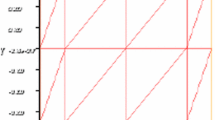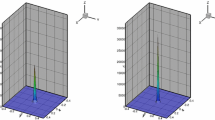Abstract
In this paper, we present an efficient adaptive moving mesh finite element method for the numerical solution of the Keller–Segel chemotaxis model. The mesh points are continuously redistributed by a coordinate transformation defined from the computational domain to the physical domain to concentrate the grid nodes in regions of large solution variations in the physical domain. The Keller–Segel equations are discretized using an implicit-explicit finite element method using piecewise polynomials defined on triangular meshes. The spatial discretization scheme is designed with a positivity preserving property, if the initial solutions of the physical model are positive then the computed solutions stay positive at all time levels. Several numerical experiments are presented to demonstrate the performance of the proposed method for solving Keller–Segel model. The numerical results show that the proposed method can reduce the computational cost while improving the overall accuracy of the computed solutions of the Keller–Segel model.







Similar content being viewed by others
References
Keller, E.F., Segel, L.A.: Initiation of slime mold aggregation viewed as an instability. J. Theor. Biol. 26, 399–415 (1970)
Keller, E.F., Segel, L.A.: Model for chemotaxis. J. Theor. Biol. 30, 225–234 (1971)
Keller, E.F., Segel, L.A.: Traveling bands of chemotactic bacteria: a theoretical analysis. J. Theor. Biol. 30, 235–248 (1971)
Alder, J.: Chemotaxis in bacteria. Ann. Rev. Biochem. 44, 341–356 (1975)
Bonner, J.T.: The Sellular Slime Molds. Princeton University Press, Princeton (1967)
Budrene, E.O., Berg, H.C.: Complex patterns formed by motile cells of escherichia coli. Nature 349, 630–633 (1991)
Budrene, E.O., Berg, H.C.: Dynamics of formation of symmetrical patterns by chemotactic bacteria. Nature 376, 49–53 (1995)
Childress, S., Percus, J.K.: Nonlinear aspects of chemotaxis. Math. Biosci. 56, 217–237 (1981)
Cohen, M.H., Robertson, A.: Wave propagation in the early stages of aggregation of cellular slime molds. J. Theor. Biol. 31, 101–118 (1971)
Herrero, M., Medina, E., VelÃzquez, J.: Finite-time aggregation into a single point in a reaction-diffusion system. Nonlinearity 10(6), 1739–1754 (1997)
Herrero, M., Velázquez, J.: A blow-up mechanism for a chemotaxis model. Ann. Scuola Norm. Sup. Pisa Cl. Sci. 24, 633–683 (1997)
Marrocco, A.: Numerical simulation of chemotactic bacteria aggregation via mixed finite elements. ESIAM: Math. Model. Numer. Anal. 37(4), 617–630 (2003)
Filbet, F.: A finite volume scheme for the Patlak–Keller–Segel chemotaxis model. Numer. Math. 104(4), 457–488 (2006). https://doi.org/10.1007/s00211-006-0024-3
Saito, N.: Conservative upwind finite-element method for a simplified Keller–Segel system modelling chemotaxis. IMA J. Numer. Anal. 27(2), 332–365 (2007). https://doi.org/10.1093/imanum/drl018
Chertock, A., Kurganov, A.: A second-order positivity preserving central-upwind scheme for chemotaxis and haptotaxis models. Numer. Math. 111(2), 457–488 (2008). https://doi.org/10.1007/s00211-008-0188-0
Tyson, R., Stern, L.J., Leveque, R.J.: Fractional step methods applied to a chemotaxis model. J. Math. Biol. 41, 455–475 (1996)
Li, X., Shu, C., Yang, Y.: Local discontinuous Galerkin method for the Keller–Segel chemotaxis model. J. Sci. Comput. 73, 943–967 (2017)
Epshteyn, Y., Kurganov, A.: New interior penalty discontinuous Galerkin methods for the Keller–Segel chemotaxis model. SIAM J. Numer. Anal. 47, 368–408 (2008)
Budd, C., Carretero-González, R., Russell, R.: Precise computations of chemotactic collapse using moving mesh methods. J. Comput. Phys. 202(2), 463–487 (2005). https://doi.org/10.1016/j.jcp.2004.07.010
Thompson, J.F., Warsi, Z.U.A., Mastin, C.W.: Numerical Grid Generation: Foundations and Applications. North-Holland Publishing Co., New York (1985)
Dorfi, E., Drury, L.: Simple adaptive grids for 1-D initial value problems. J. Comput. Phys. 69(1), 175–195 (1987). https://doi.org/10.1016/0021-9991(87)90161-6
Huang, W., Ren, Y., Russell, R.D.: Moving mesh partial differential equations (MMPDES) based on the equidistribution principle. SIAM J. Numer. Anal. 31(3), 709–730 (1994)
Huang, W., Russel, R.D.: Adaptive Moving Mesh Methods. Springer, New York (2011)
Sulman, M., Williams, J.F., Russell, R.D.: Optimal mass transport for higher dimensional adaptive grid generation. J. Comput. Phys. 230(9), 3302–3330 (2011)
Strehl, R., Sokolov, A., Kuzmin, D., Horstmann, D., Turek, S.: A positivity-preserving finite element method for chemotaxis problems in 3D. J. Comp. Appl. Math. 239(1), 290–303 (2013)
de Boor, C.: Good approximation by splines with variable knots. II. In: Conference on the Numerical Solution of Differential Equations (Univ. Dundee, Dundee, 1973), pp. 12–20. Lecture Notes in Math., Vol. 363. Springer, Berlin (1974)
Huang, W.: Practical aspects of formulation and solution of moving mesh partial differential equations. J. Comput. Phys. 171(2), 753–775 (2001)
Benamou, J.D., Brenier, Y.: A computational fluid mechanics solution to the Monge–Kantorovich mass transfer problem. Numer. Math. 84(3), 375–393 (2000)
Knott, M., Smith, C.S.: On the optimal mapping of distributions. J. Optim. Theory Appl. 43(1), 39–49 (1984)
Brenier, Y.: Polar factorization and monotone rearrangement of vector-valued functions. Comm. Pure Appl. Math. 44(4), 375–417 (1991)
Sulman, M., Williams, J., Russell, R.D.: An efficient approach for the numerical solution of the Monge–Ampère equation. Appl. Numer. Math. 61(3), 298–307 (2011)
Kuzmin, D.: On the design of general-purpose flux limiters for finite element schemes. I. Scalar convection. J. Comput. Phys. 219(2), 513–531 (2006). https://doi.org/10.1016/j.jcp.2006.03.034
Kuzmin, D.: Explicit and implicit FEM-FCT algorithms with flux linearization. J. Comput. Phys. 228(7), 2517–2534 (2009). https://doi.org/10.1016/j.jcp.2008.12.011
Horstmann, D.: From 1970 until present: the Keller–Segel model in chemotaxis and its consequences I. Jahresber. DMV 105, 103–165 (2003)
Horstmann, D.: From 1970 until present: the Keller–Segel model in chemotaxis and its consequences II. Jahresber. DMV 106, 51–69 (2004)
Epshteyn, Y., Kurganov, A.: Upwind-difference potentials method for Patlak–Keller–Segel chemotaxis model. J. Sci. Comput. 53, 689–713 (2012)
Aida, M., Tsujikawa, T., Efendiev, M., Yagi, A., Mimura, M.: Lower estimate of the attractor dimension for a chemotaxis growth system. J. Lond. Math. Soc. 74(2), 453–474 (2006)
Strehl, R., Sokolov, A., Kuzmin, D., Horstmann, D., Turek, S.: A flux-corrected finite element method for chemotaxis problems. J. Comput. Appl. Math. 10(2), 219–232 (2010)
Acknowledgements
The second author was partially supported by the NSF MRI Award No. 1531923, and would like to acknowledge the funding he received from the Graduate School at Wright State University.
Author information
Authors and Affiliations
Corresponding author
Additional information
Publisher's Note
Springer Nature remains neutral with regard to jurisdictional claims in published maps and institutional affiliations.
Rights and permissions
About this article
Cite this article
Sulman, M., Nguyen, T. A Positivity Preserving Moving Mesh Finite Element Method for the Keller–Segel Chemotaxis Model. J Sci Comput 80, 649–666 (2019). https://doi.org/10.1007/s10915-019-00951-0
Received:
Revised:
Accepted:
Published:
Issue Date:
DOI: https://doi.org/10.1007/s10915-019-00951-0




